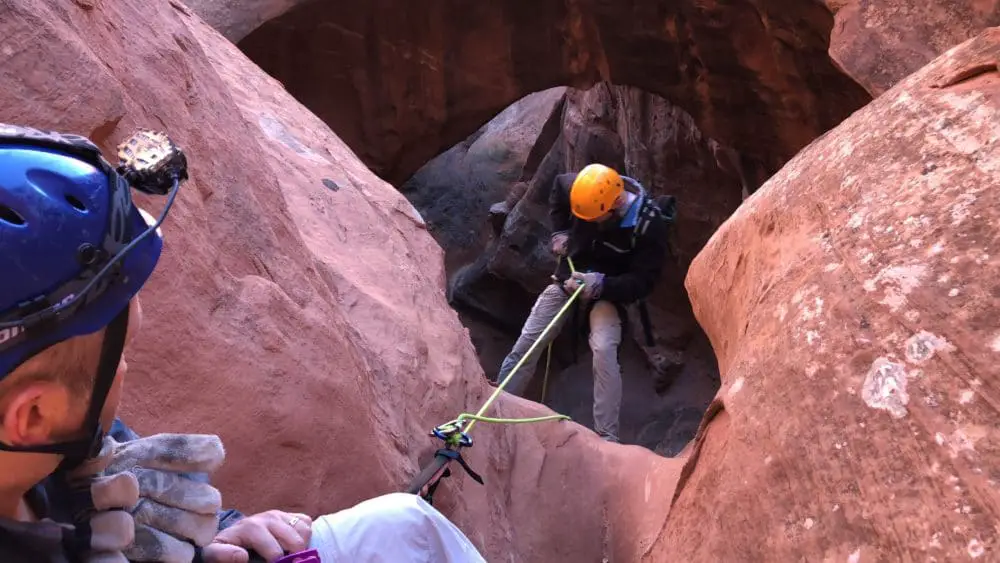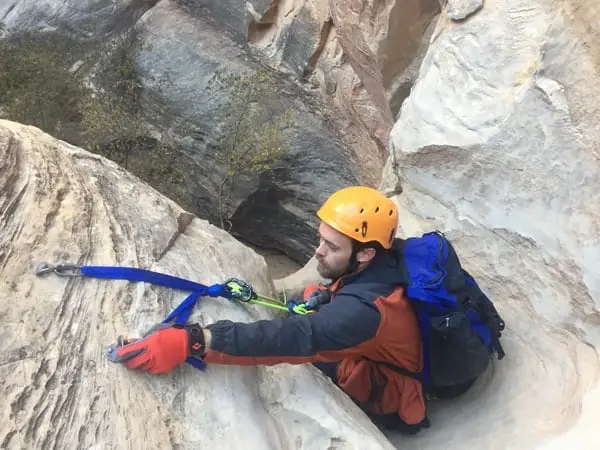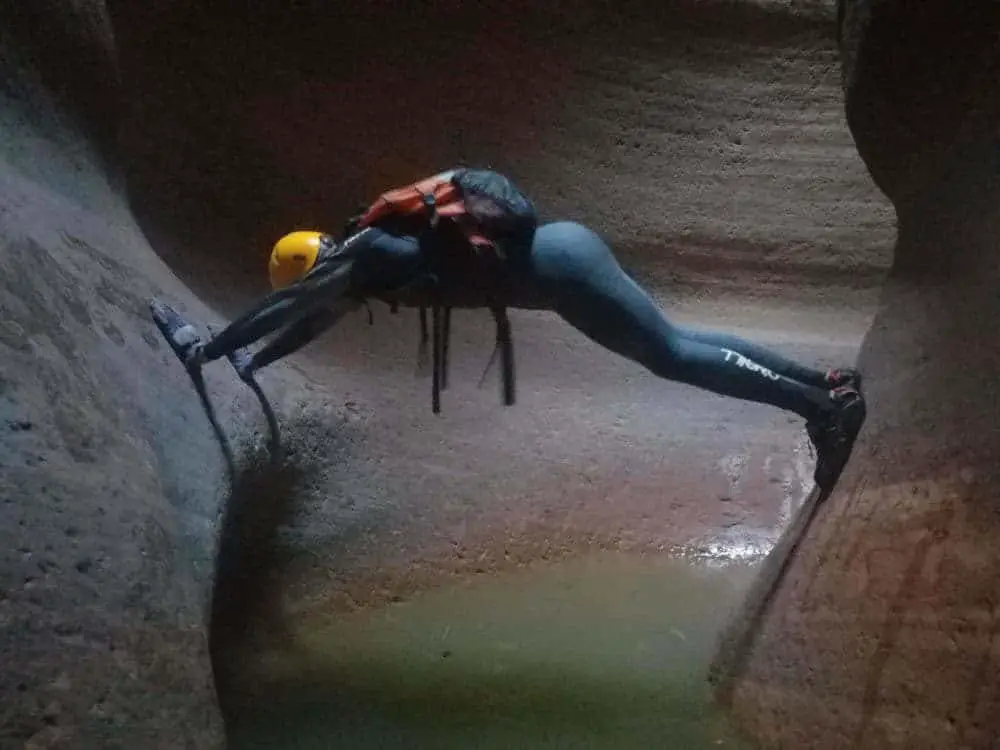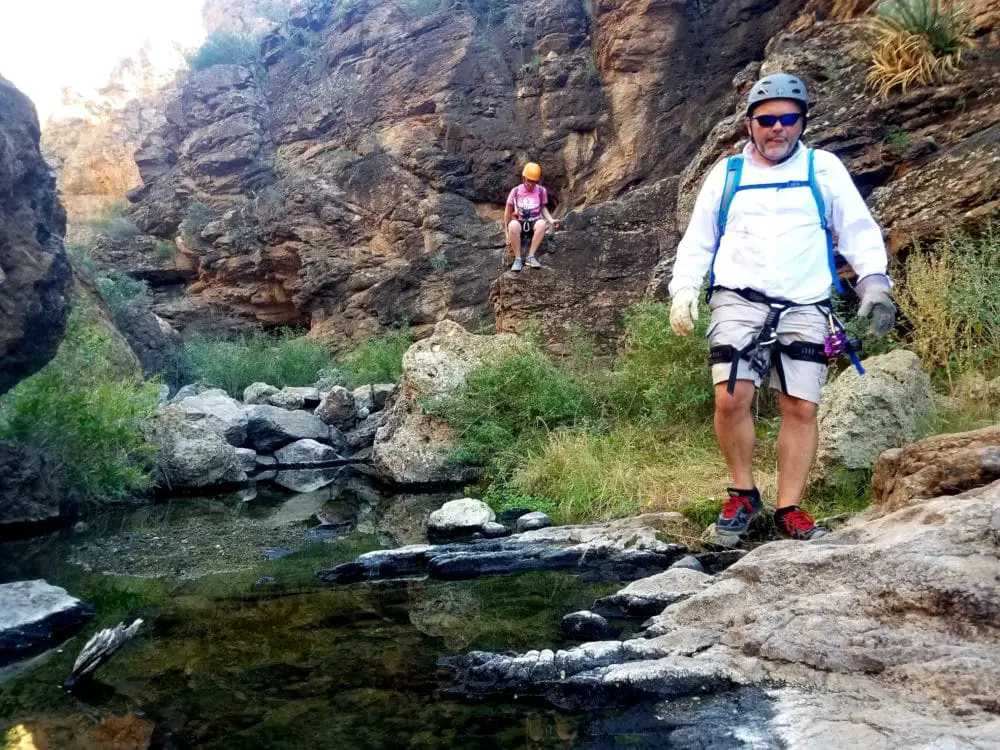Conditions can change in a matter of minutes. Temperatures vary wildly between the surface of the earth and the depths of the cracks and crevices canyoneers find themselves in. You need to think twice about what you are wearing before putting yourself in an extreme environment with no easy escape. The clothing you wear canyoneering/Canyoning can be every bit as valuable and important as any technical gear you bring- in terms of safety and survival.
While you can probably get by with wearing whatever you feel like when going on day hikes or to your local crag, canyoneering warrants special care. In most situations you cannot simply turn around and run back to the car or find shelter under a tree for a few minutes. Once you drop into the canyon, you are committed to finishing it and you need to be prepared for every situation. Space and weight are the limiting factors to what you can actually haul on your back, so it’s important to know what you need and not bring extra baggage.

What to Wear Canyoneering?
- Quick-drying Long Sleeve Shirt
- Weatherproof Jacket
- Quick-drying Long Pants
- Quick-drying Base Layer
- Canyoneering Shoes
- Gloves for Rappelling
- Sun Hat & Helmet
- Neoprene Socks (wet canyons)
- Wetsuit (wet canyons)
What follows is the full guide of everything you need to know before going canyoneering for the first time. It’s crucial to be prepared for any scenario canyoneering, so what you wear is important.
Best Shirts for Canyoneering:
I usually wear a t-shirt with a wind shirt on top. The t-shirt should be moisture-wicking and quick-drying. A wind shirt is a button-up long-sleeved shirt. It serves multiple functions as sun protection while above the walls of the canyon or between slot sections and as a protection for your arms against abrasive canyon walls and poisonous plants.
Avoid cotton because it dries really slowly and traps cold water close to the body. Synthetic materials like polyester are designed to wick sweat and moisture away from the body, and to dry quickly.
During wet sections like swimmers or potholes (learn how to escape a keeper hole ) I put the wind shirt in my dry bag (see recommended backpacks)
) I put the wind shirt in my dry bag (see recommended backpacks) to keep it dry in case I get cold later. Don’t underestimate how much switching to a dry, long-sleeved shirt can warm you up.
to keep it dry in case I get cold later. Don’t underestimate how much switching to a dry, long-sleeved shirt can warm you up.
A wet t-shirt will cling to your body and sap away valuable heat and energy. On warmer days you can strip down after a cold swim and warm up on the rocks. They absorb the heat and often hold onto it through the evening.
It may seem petty, but I always try to wear bright colors when going canyoneering so that I stand out in pictures . Any earth tones just tend to disappear into the background. I justify it by telling myself it would be a lot easier to spot me if I ever needed to be rescued.
You can wear through the elbows of these shirts pretty quickly, so some people use elbow pads to protect them (as well as to protect their elbows from bumps and bruises).
to protect them (as well as to protect their elbows from bumps and bruises).
Amazon: Columbia Sportswear Women’s Bahama Long Sleeve Top
Amazon: Columbia Men’s Bahama II Long Sleeve Shirt

Best Canyoneering Outerwear:
While a t-shirt and shorts work in many desert environments, you may need extra layers for different situations. On cooler days, or in longer canyons, I bring a fleece jacket. A rain jacket won’t do a great job keeping you warm (don’t go if it’s going to rain!), a coat or shell is usually too bulky to fit in my bag, and a cotton-blend jacket is a disaster if it gets wet. Fleece tends to provide a lot of insulation and warmth for the relative thickness, shed water effectively, and still keep you warm if it gets wet.
A wind shirt is usually enough to keep me warm in shorter desert canyons, but I bring a fleece jacket if there’s the slightest chance of getting stuck overnight. A jacket is also necessary for many early morning starts and deep prolonged slot sections that don’t see sunlight. Again, go with bright colors!
Amazon: Columbia Women’s Ridge Repeat Half Zip Fleece
Amazon: Columbia Men’s Granite Mountain Fleece Jacket
Best Pants for Canyoneering:
Long pants are a necessity in most of Arizona  and Utah
and Utah , where every single plant has thorns and needles. If you have to do some bushwacking while wearing shorts, your legs will look like they have chicken pox at the end of the day.
, where every single plant has thorns and needles. If you have to do some bushwacking while wearing shorts, your legs will look like they have chicken pox at the end of the day.
In less arid climates, the biggest danger comes from poisonous plants like poison ivy or poison oak. Wearing long pants will protect your legs against cuts and rashes, which can easily become infected in canyon environments.

The best material to look for is Nylon, or something synthetic that is strong and provides enough stretch. Nylon works really well, and stands up to abrasive rocks and plants. As mentioned above, avoid cotton as it will just hold water. For a Class C canyon with lots of swims, I wear quick-drying shorts, or even a swimsuit with lots of pockets. I see no benefit to wearing baggy long pants that will be more difficult to swim in and take longer to dry.
with lots of swims, I wear quick-drying shorts, or even a swimsuit with lots of pockets. I see no benefit to wearing baggy long pants that will be more difficult to swim in and take longer to dry.
A lot of people like convertible Zip off pants for canyoneering because they can protect the lower leg during the approach and then convert into shorts during the wet sections. Consider picking up a pair of knee pads to protect your knees from bruising and to protect your pants from tearing through.
to protect your knees from bruising and to protect your pants from tearing through.
The best pants for canyoning are also the best pants for rock climbing. You can read more about why I picked these in this article .
.
Amazon: prAna Stretch Zion Pant
Amazon: prAna Stretch Zion Convertible Pant
Amazon: Women’s Outdoor Quick Dry Convertible Cargo Pants
Best Canyoneering Headwear:
The best headwear for canyoneering is a hat that provides sun protection and can then be worn under a helmet or stuffed into a pack. A cowboy hat or straw hat, or even a lot of baseball caps are a bad idea because they can be pretty easily damaged when buried in the bottom of a pack and ground into the mud.
My dad wears a hat through every canyon to keep the top of his head from burning- it’s not a problem I’ve had to face so far, but the hat he uses definitely does the job. He wears a stuffable brimmer hat.
In colder weather, I like a hat with fold down ear flaps that fits under the helmet. Your ears and face freeze in the snow, so the extra flaps provide some added warmth. A beanie can often be too hot once you really get moving.
Always wear a helmet! Your brain is worth at least the $50 price tag of a cheap climbing helmet, and you won’t be much good in a canyon with a concussion-or worse. The volatile conditions and challenging physical features, not to mention the potential for falling rocks and gear make a helmet an absolutely crucial piece of gear.
For canyoneering helmet recommendations, check out our recommended gear page
Amazon: Outdoor Research Helios Sun Hat
Amazon: Outdoor Research Boiler Cap (ear flaps)
(ear flaps)
Best Gloves for Canyoneering:

The gloves I used to use for canyoneering were just simple leather gloves from any hardware store. They protect your hands from abrasive surfaces, and keep you from getting rope burns on fast rappels. The downside is that they never fit very snugly on your hands, and don’t provide additional grip through downclimbing sections. This is especially difficult for people with smaller hands. Leather gloves also don’t feel great when they get wet, though they continue to function the same.
Climbing companies like Black Diamond and Petzl make gloves specific for rappelling that cost 10-15 times as much (hardware gloves are cheap!), though they fit snugly (like a glove…) and are made of thicker leather. Longer rappels can burn through thin hardware store gloves, so I finally bought a pair of Black Diamond Crag Gloves and haven’t looked back. I can adjust all my gear without taking my gloves off, and can rappel without worrying about burning through thin gloves.
The recent trend in canyoneering gloves is to use gardening-style gloves with a lot of rubber grip on the palms. The upside is that they are also cheap, and they provide a lot of added grip to sandstone walls and ropes; however, you have to rappel a lot slower (with added friction ) or you will burn right through them.
) or you will burn right through them.
Rubber-palmed gloves can really increase your ability to downclimb. What are the best gloves for canyoneering? Leather gloves for fast rappellers, and rubber-palmed gloves for slower rappellers.
Rock Climbing Gloves:
Amazon: Black Diamond Crag Glove s
s
Leather Work Gloves:
Amazon: 3prs Cow Split Leather Work Gloves
Rubber-palmed gloves:
Amazon: Atlas Workhorse Gloves
Best Canyoneering Footwear:
Canyoning requires a lot of very delicate moves that are often right on the edge of cliffs. Complicate it by adding water and moss, which make even the roughest of rocks smooth, and it ends up being a lot like walking on ice in places. Regular tennis shoes and hiking boots can work pretty well, but test them out first. Some tennis shoes turn into ice skates when they get wet, and some hiking boots feel like cement blocks when they’re wet.
When picking a pair of shoes to take into a canyon, you need to look for a pair with specific features. The best canyoneering shoes have really grippy rubber, offer strong ankle support, drain well, and can take a beating. Avoid waterproof shoes because they will make swimming more difficult and won’t drain while you hike. I recommend looking approach shoes designed for rock climbing because of the superior grip and durability.
Five Ten makes a shoe specifically designed for canyoneering, but they’re pretty pricey for an activity you can’t really do very often. As of 2019, they announced they are no longer going to make them too. The Adidas Terrex family of shoes work really well for canyoning. Specifically, I use the Terrex Voyager Aqua Shoe (view on Amazon
(view on Amazon )
)

The best pair of shoes I’ve used is a pair of Nike Hiking boots (my “Nike Hikees”), surprisingly enough. Somehow they grip the rock like climbing shoes, and drain really well after water sections. Unfortunately, they only lasted a few years. In canyons that follow a permanent stream or river, I wear hiking sandals that cover my toes and heels, but still drain out. You don’t want to stub your toes on rocks below the surface of a muddy stream.
Check out our comprehensive guide to Canyoneering Footwear for more information and the shoes that we recommend.
for more information and the shoes that we recommend.
Canyoneering Socks
Your feet will get really cold in wet canyons, and shoes don’t do anything to keep them warm once they’re wet. Cotton socks do a great job of absorbing water and keeping your foot wet all day, which is exactly what you don’t want!
The best socks for canyoneering in wet canyons are neoprene socks. They work like a wetsuit, trapping the water that gets in close to your body so it warms up. Consider buying a pair of shoes in a bigger size so they fit with neoprene socks in case you plan on doing some cold weather or cold water canyoneering. For all other canyons, including dry canyons and warmer wet canyons, merino wool socks work really well to shed water and sweat away from your feet.
You can see our recommendations for canyoneering socks in this article –
–
Best Wetsuit for Canyoneering: (Wet Canyons)
Depending on the season and the amount of water involved, a wetsuit can be a necessity. Wetsuits usually limit your flexibility and decrease your comfort, so hike in your regular clothes, and then throw your wetsuit on right at the top of the canyon.
It is always significantly colder in the bottom of a canyon, and most canyon water never sees sunlight. I’ve been the only canyoneer in my group with a wetsuit a few times, and it makes a huge difference! I never thought I would own a wetsuit, living in Utah and Arizona, but it has been well worth it!

Soaking in cold water, and then waiting around in cold, wet clothes saps the heat and energy from your body. A wetsuit does a great job trapping the heat emitted by your body, especially when vigorously swimming or treading water. When you finish the wet sections of a canyon, it’s important to change back into dry clothing as soon as possible. While the wetsuit does keep you warmer, it still traps water close to the body and will cool you down.
For most canyons I go for a 3mm shortie just to keep my core warm, but a full length wetsuit is better for colder climates and seasons. A full length wetsuit is necessary for canyons with long swimming sections in cold water, especially when there’s nowhere to warm up in between swims. Wear a pair of shorts and a t-shirt over the top of your wetsuit to protect it against abrasion. Clothing is a lot cheaper to replace than a wetsuit!
If you plan on going in the winter, you may consider investing in a dry suit. They are designed to keep you completely dry inside, as opposed to wetsuits that trap water close to the skin so that you warm it up. The downside is that they are less durable (more likely to rip), and cost a lot more money.
For more information on wetsuits for canyoneering and which ones we use, check out this article we wrote .
.
Ready to get out there?
Close your browser and get out there into the wild! If you’re sitting at work though, and need a bit more of a break, check out some of the other canyoneering, rappelling, and rock climbing information on our site.
Read what we’ve written about the Best Beginner’s Canyons in Arizona and the Top 5 Places to Canyoneer in Utah and make your plan!
and make your plan!
Other Canyoneering Gear:
You may be able to navigate the most basic Class 2 canyons with the right sets clothing and shoes, but for anything more intense, you’ll need an array of technical gear and route finding capabilities. Whether you’re brand new to the sport or you’re a seasoned veteran, it’s really beneficial to put together a gear list and adhere to it for each trip. You can’t get to the top of the 3rd rappel only to realize you don’t have enough webbing to build a safe anchor
with the right sets clothing and shoes, but for anything more intense, you’ll need an array of technical gear and route finding capabilities. Whether you’re brand new to the sport or you’re a seasoned veteran, it’s really beneficial to put together a gear list and adhere to it for each trip. You can’t get to the top of the 3rd rappel only to realize you don’t have enough webbing to build a safe anchor !
!
Read the article What Gear do I Need for Canyoneering and create a list specific to any additional needs your crew may have. Practice using the gear, and especially rigging rappels
and create a list specific to any additional needs your crew may have. Practice using the gear, and especially rigging rappels (how to rig a retrievable rappel
(how to rig a retrievable rappel ) at home or in another safe place before testing yourself out in the wild.
) at home or in another safe place before testing yourself out in the wild.
Emergencies:
In an emergency situation like an incoming storm, injury, or nightfall, it’s crucial that you are prepared. Carrying something small like a firestarter or an emergency blanket could mean the difference between life and death. We put together a list of emergency gear that we bring to every canyon that you can find at this link .
.
SAR will make it to you eventually, but your best bet is to self-rescue. Plan ahead so you are ready when disaster strikes! You should have a pre-assembled emergency kit ready for all of the outdoor adventures you participate in. Most of them require similar gear, but there are some specialties occasionally required, such as tube repair kits for mountain biking or tent pole repair kits for backpacking.
See Also:
Is Canyoning Dangerous? Canyoneering Safety Tips

